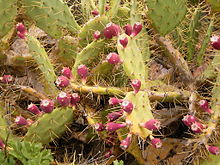Opuntia stricta
| Opuntia stricta | |
|---|---|
 |
|
| Opuntia stricta in fruit, Canary Islands. | |
| Scientific classification | |
| Kingdom: | Plantae |
| (unranked): | Angiosperms |
| (unranked): | Eudicots |
| (unranked): | Core eudicots |
| Order: | Caryophyllales |
| Family: | Cactaceae |
| Genus: | Opuntia |
| Species: | O. stricta |
| Binomial name | |
|
Opuntia stricta (Haw.) Haw. |
|
| Varieties | |
|
O. s. var. dillenii (Ker Gawl.) L.D.Benson |
|
| Synonyms | |
|
See text. |
|
O. s. var. dillenii (Ker Gawl.) L.D.Benson
O. s. var. dillenii (Haw.) Haw.
See text.
Opuntia stricta is a large sized species of cactus that is endemic in the subtropical and tropical coastal areas of the Americas and the Caribbean. Common names include erect prickly pear nopal estricto (Spanish). It is an erect or sprawling shrub up to 2 m (6.6 ft) in height, producing lemon yellow flowers in the spring and summer, followed by purplish-red fruits. It is quick to colonize hot, open environments with sandy soils.
Opuntia stricta occurs naturally in South Carolina, Georgia, Florida, and along the Gulf Coast in Texas, Mississippi, and Alabama in the United States , as well as the Bahamas, Bermuda, the Caribbean, eastern Mexico, Central America, northern Venezuela, and Ecuador.
It has been introduced to many parts of the world, including Africa, Southern Europe, and southern Asia. O. stricta is considered an invasive species in South Africa. In Australia it has been the subject of one of the first really effective biological control exercises using the moth Cactoblastis cactorum. It was declared a Weed of National Significance by the Australian Weeds Committee in April 2012, but continues to be kept under control by the use of the Cactoblastis moth and a cochineal insect, Dactylopius opuntiae.
...
Wikipedia
